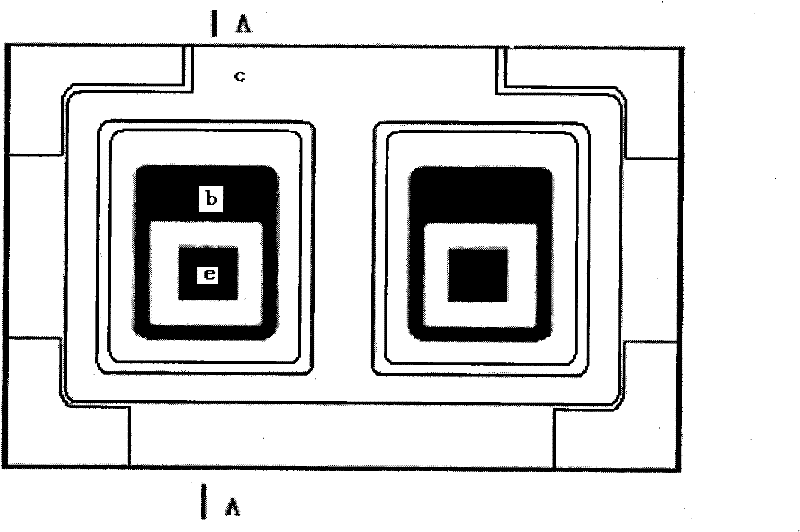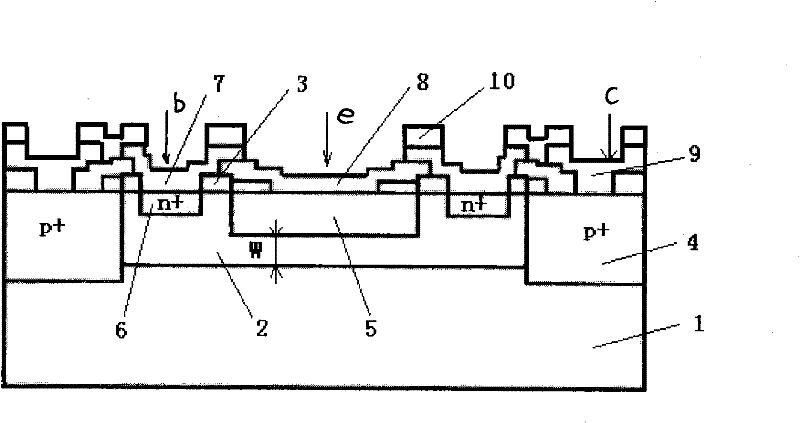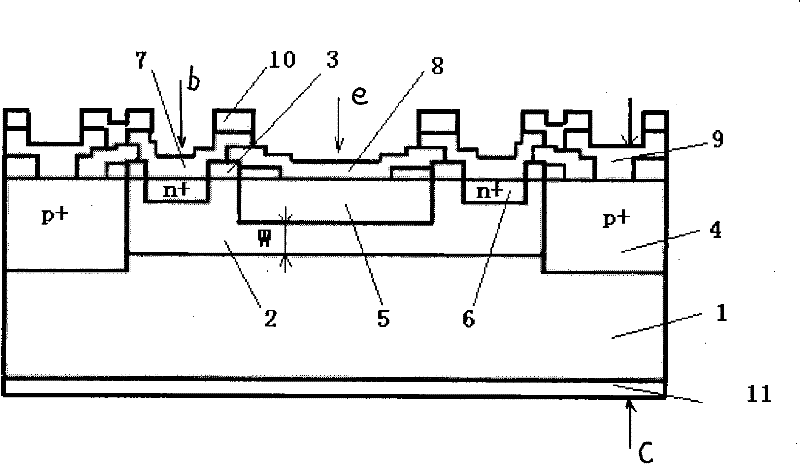Method for manufacturing integrated PNP differential pair tube
A manufacturing method and technology of differential pair tubes, which are applied in the manufacture of semiconductor/solid-state devices, electrical components, circuits, etc., can solve the problems of low reverse amplification factor, good symmetry of differential pair tubes, and high frequency, and reduce the saturation voltage drop. , the effect of high reliability
- Summary
- Abstract
- Description
- Claims
- Application Information
AI Technical Summary
Problems solved by technology
Method used
Image
Examples
Embodiment 1
[0018] 1. If figure 1 with figure 2 As shown, the single-sided polished P+ silicon substrate 1 with crystal orientation has a resistivity of 0.001 ohm-cm, and an epitaxial layer is grown on the silicon substrate 1 as the N-base region 2, and the resistivity is 0.2 ohm-cm , with a thickness of 20 μm, an oxide layer 3 is grown by thermal oxidation;
[0019] 2. Diffusion of boron on the surface of the N base region 2 by photolithographic masking and etching, and the temperature of re-diffusion is 1160°C. The diffused boron junction is connected to the P+ silicon substrate 1 as the common P+ collector region 4 and forms a protective ring, and the epitaxial layer is separated into Two independent base regions, the surface impurity concentration of P+ collector region 4 is 10 20 / cm 3 ;
[0020] 3. Diffuse boron on the surface of the N-base region 2 to form a discrete emission region 5 through photolithographic masking and etching, and then diffuse at a temperature of 1000°C, ...
Embodiment 2
[0024] 1. If figure 1 with figure 2 As shown, the crystal direction is selected to polish the P+ silicon substrate 1 on one side, and its resistivity is 0.008 ohm-cm. An epitaxial layer is grown on the silicon substrate 1 as the N base region 2, and the resistivity is 2.0 ohm-cm. The thickness is 10 μm, and a layer of oxide layer 3 is grown by thermal oxidation;
[0025] 2. Diffusion of boron on the surface of the N base region 2 by photolithographic masking and etching, and the temperature of re-diffusion is 1200°C. The diffused boron junction is connected to the P+ silicon substrate 1 as the common P+ collector region 4 and forms a guard ring, and the epitaxial layer is separated into Two independent base regions, the surface impurity concentration of P+ collector region 4 is 4×10 19 / cm 3 ;
[0026] 3. Diffuse boron on the surface of the N-base region 3 to form the emitter region 5 by photolithographic masking and etching, and then diffuse at a temperature of 1160°C, ...
Embodiment 3
[0030] 1. If figure 1 with figure 2 As shown, the crystal direction is selected to polish the P+ silicon substrate 1 on one side, and its resistivity is 0.005 ohm-cm. An epitaxial layer is grown on the silicon substrate 1 as the N base region 2, and the resistivity is 1.0 ohm-cm. The thickness is 15 μm, and a layer of oxide layer 3 is grown by thermal oxidation;
[0031] 2. Diffuse boron on the surface of the N-base region 2 through photolithographic masking and etching, and the temperature of the re-diffusion is 1190°C. The diffused boron junction is connected to the P+ silicon substrate 1 as the common P+ collector region 4 and forms a guard ring, and the epitaxial layer is separated into Two independent base regions, the surface impurity concentration of P+ collector region 4 is 6×10 19 / cm 3 ;
[0032] 3. Diffuse boron on the surface of the N-base region 3 to form the emission region 5 by photolithographic masking and etching, and then diffuse at a temperature of 103...
PUM
| Property | Measurement | Unit |
|---|---|---|
| thickness | aaaaa | aaaaa |
| thickness | aaaaa | aaaaa |
| thickness | aaaaa | aaaaa |
Abstract
Description
Claims
Application Information
 Login to View More
Login to View More - R&D
- Intellectual Property
- Life Sciences
- Materials
- Tech Scout
- Unparalleled Data Quality
- Higher Quality Content
- 60% Fewer Hallucinations
Browse by: Latest US Patents, China's latest patents, Technical Efficacy Thesaurus, Application Domain, Technology Topic, Popular Technical Reports.
© 2025 PatSnap. All rights reserved.Legal|Privacy policy|Modern Slavery Act Transparency Statement|Sitemap|About US| Contact US: help@patsnap.com



